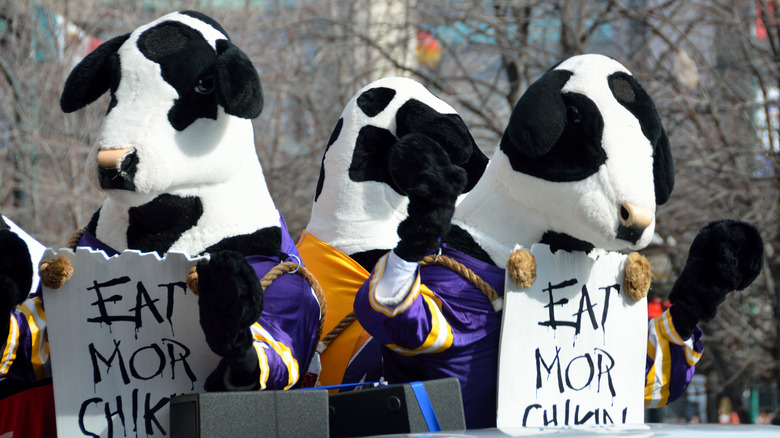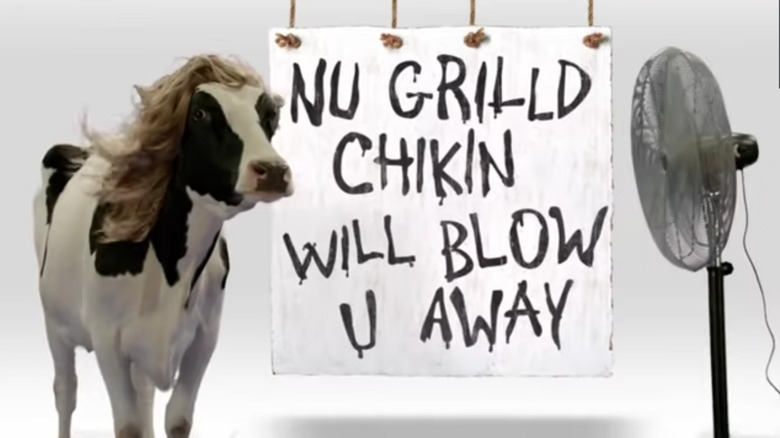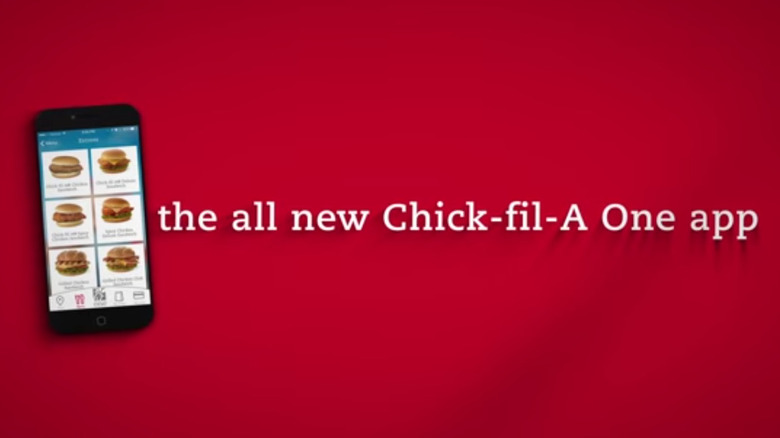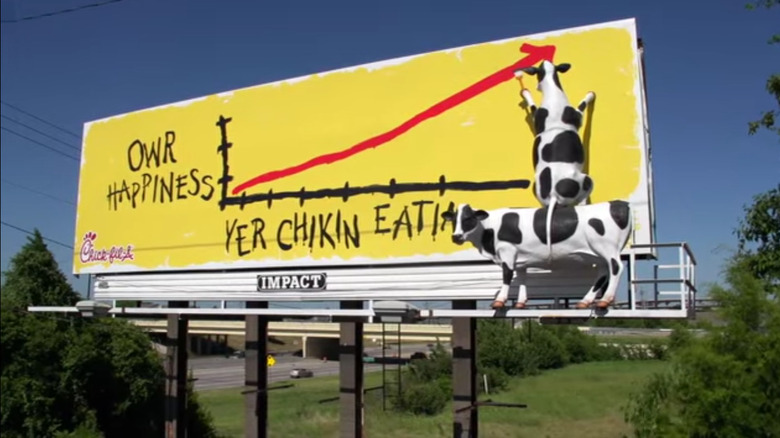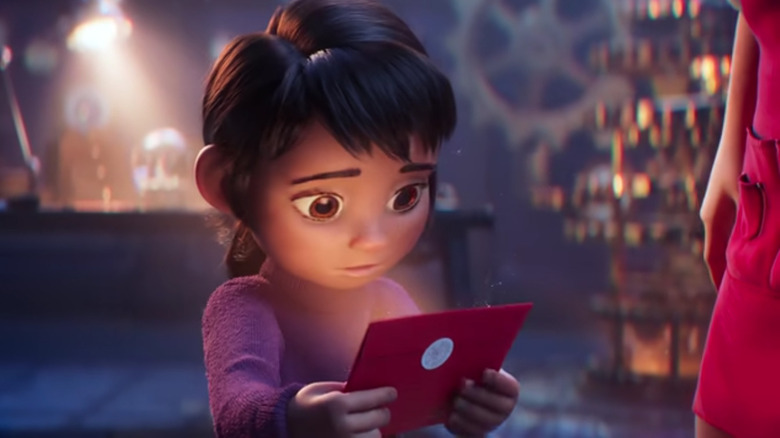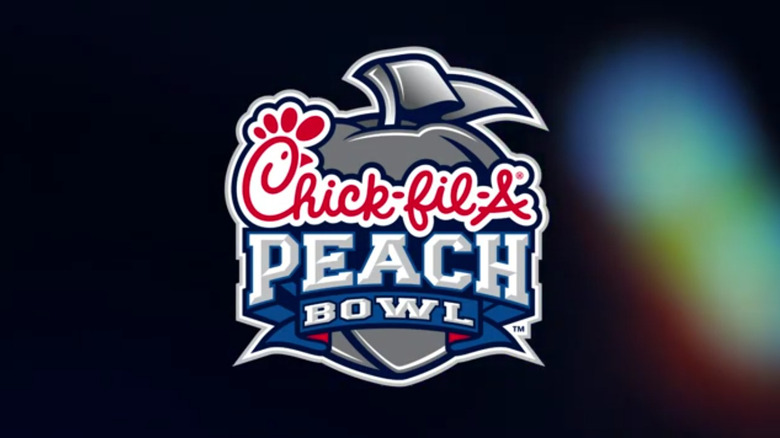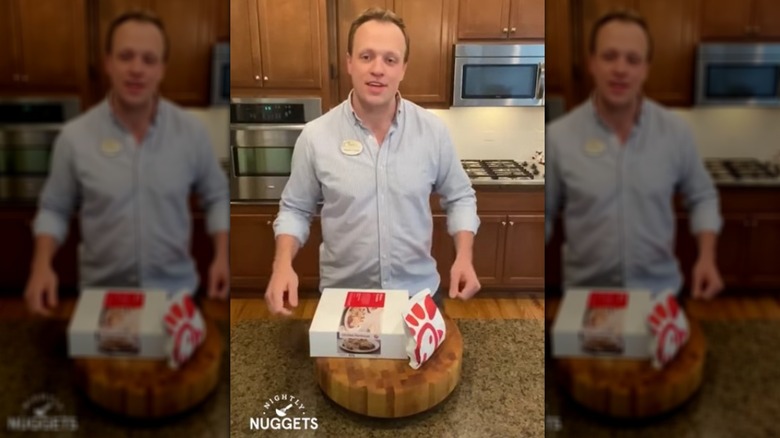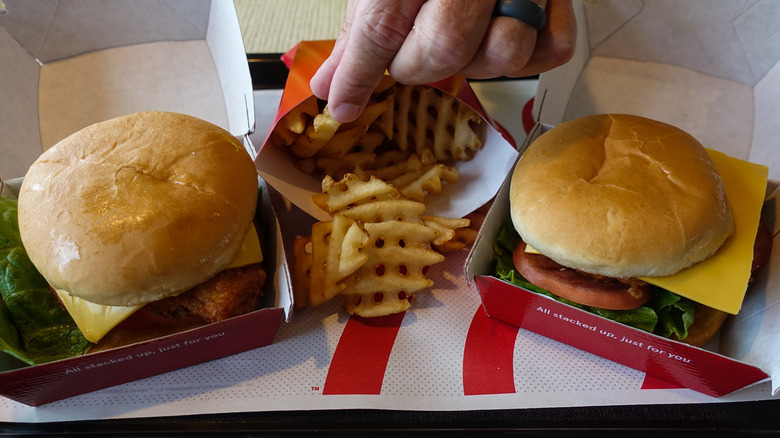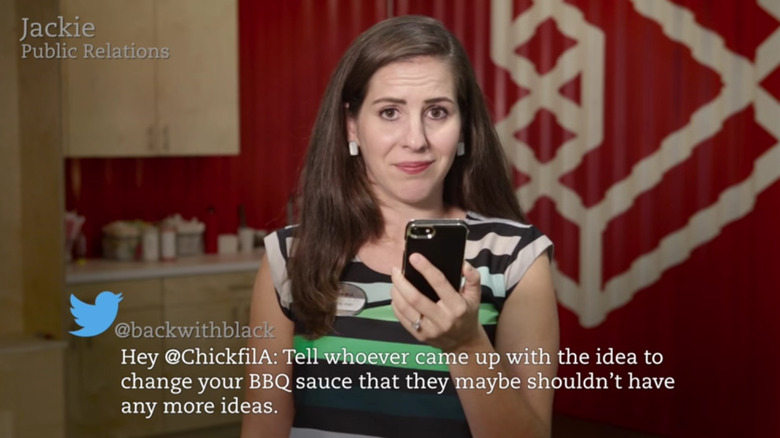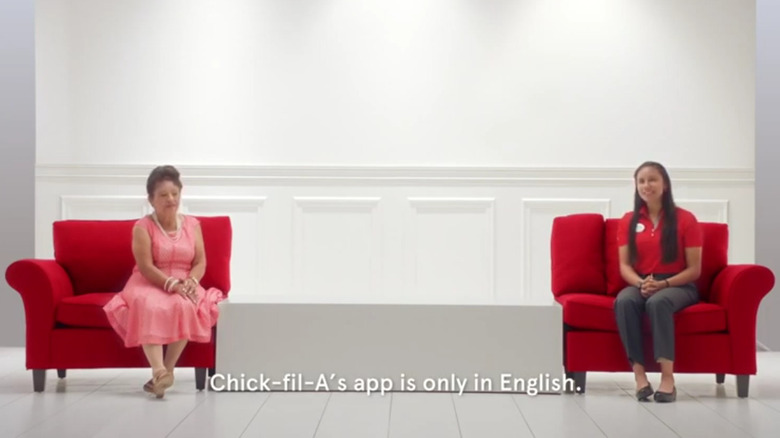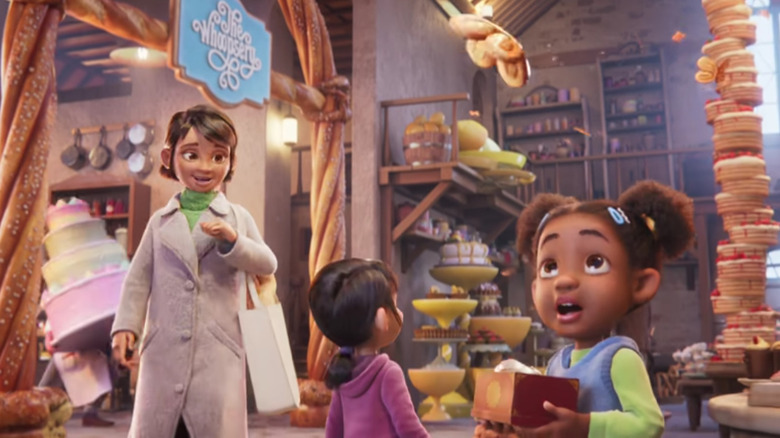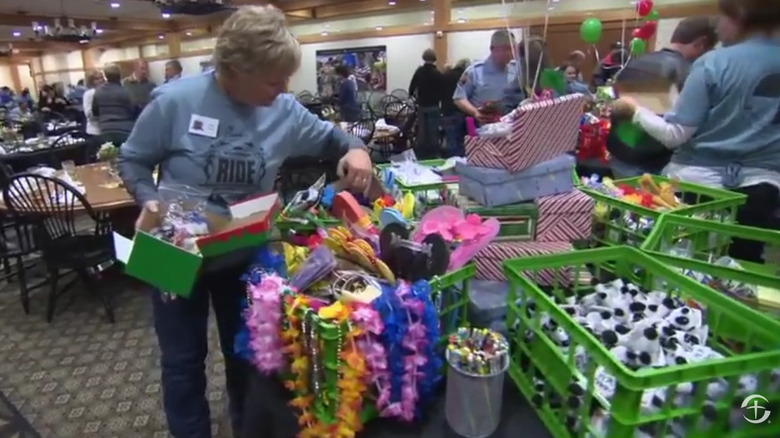The Most Mouth-Watering Chick-Fil-A Marketing Campaigns Of All Time
When it comes to advertising, dare we say that the Hallmark Channel ain't got nothing on Chick-fil-A? All the optics are there. These days, Chick-fil-A ads are filled with all the "aww, shucks" small-town kind of imagery that usually fills your average Hallmark Christmas special: Families staring in wonder at the town's Christmas tree lighting; mom putting the finishing touches on a cookie; and a hug between an employee and a customer highlighting a friendship that developed over the return of some forgotten change. And we can't forget the current cream of the crop in the chicken giant's advertising arsenal, an animated series of short films that warm your heart so much you wish you could live inside of them in the way that people say they want to live inside a Thomas Kinkade painting.
None of this is to say that Chick-fil-A has forgotten the graffiti-wielding cows that put the company on the map, or shall we say, the billboard? Those live on, too, occasionally as fodder for commercials but more often as soft plush toys that may one day reach the status of Beanie Babies and sell for $159,000 on eBay on a good day. It would be easy to fall into the roll-your-eyes kind of cynicism that often accompanies gushing of this sort except some pretty big names in the marketing and advertising world, like Inc.com, have singled out the chicken sandwich company's ads, calling at least one of them the top ad of the year.
Eat Mor Chikin boasts amazing longevity
If you knew nothing about Chick-fil-A, its mascot would be a headscratcher. Really, what business do Holstein cows have in a chicken sandwich ad? After all, if you attend a Boise State Broncos game, you expect Buster Bronco and not Holly Holstein to march across the blue turf at halftime. Ah, but that's the beauty of the "Eat Mor Chikin" campaign. In 1995, the business introduced the ultimate bait-n-switch in its now-famous ad campaign. Rather than stuff its ads with plump chickens ready to be plucked, the chicken sandwich company stuffed its ads with rather plucky cows.
But that's not all. Working with the fervor of clandestine graffiti artists on a subway in New York City, the cows got busy tagging billboards up and down highways with the slogan "Eat Mor Chikin'" in life-sized black letters. In a world where fast food burger joints are advertised daily on drive-time radio ads, the not-so-subtle subtext of the marketing campaign was, of course, that chicken makes a far better dinner than a burger ever could. Fortunately, 25 years on and counting, the cows' brazen humor is still funny to the chikin'-eatin' public no matter which media these bovines appear in. Now, decked out in high-fashion wigs, they star in ads on YouTube, Instagram, and more. And the oversized stuffed plush-toy version of these moo-sters is also the ultimate prize for kiddies visiting the local Chick-fil-A for dinner. You won't find that in a kiddie burger box.
The Chick-fil-A One app offers VIP service
The money is in the list. It's a mantra so sacred to marketing and advertising gurus that they chant it with more regularity than a Buddhist monk chants "Om." But saying it is one thing. Building an email list that actually makes your company money is a whole other basket of eggs. Chick-fil-A put its money where its Peeps are, building its list via the Chick-fil-A One app.
The app prompts users to cough up their email addresses in exchange for reward points and goodies. For users of the app, that ain't nothin'. The rewards system offers several membership tiers, with the Signature Membership being crème de la crème. If you've ever been to a rock concert and paid for the VIP experience, then you have a pretty good idea of what the top-tier experience is like, and yes, it actually does include a backstage tour, probably complete with a meet-and-greet, at the home office.
However, bells and whistles and email lists mean nothing if they're not used. Given that it has been rated by LifeWire as one of the Top 10 Restaurant apps of 2023 and has been downloaded more than 10 million times on Google Play, the Chick-fil-A One app puts to rest any cynicism about its success. And that's just on Google Play. Fans can access the app via the Apple Store and the chain's website, too, ensuring that this email nest egg is always producing more hatchlings.
Sharing humor on billboards for 25-plus years
At an average of $850 per month, billboard ads are budget-friendly affairs compared with TV ads, which can require tens of thousands of dollars more depending on time slot, scale, and production costs. The problem with budget-friendly is that it also often equals banal, and banal is akin to bankrupt because who pays attention to banal? As it turns out, if it's a billboard with a couple of three-dimensional cows on it, a lot of people pay attention. We speak, of course, of Chick-fil-A's innovative use of 3D billboards in the mid-1990s and the "Eat Mor Chikin" ads that put the chain on the fast food map. What the company lacked in marketing money, it made up for in marketing moxie.
Although other companies' billboards have featured 3D elements, like McDonald's giant lunch bags, it was the combination of the 3D element coupled with the quirkiness of life-sized cows tagging a billboard with chicken scratch writing that made Chick-fil-A's campaign so memorable. It probably helped that almost 90% of consumers report remembering Out-of-Home (OOH) ads. Outdoor advertising campaigns have a greater recall factor than any other ad type.
Today, those billboard-taggin' cows are still at their antics but have expanded their efforts beyond the side of the highway. Ardent lovers of all things chicken sandwich proudly wear T-shirts and sweatshirts with the famous cows on them, effectively taking these billboard ads into the streets everywhere, making these walking advertisements the ultimate 3D billboards.
Together Time capitalizes on in-person engagement
In a 2019 Bantam Group Survey commissioned by Chick-fil-A, over 90% of respondents agreed that the best holidays equaled time with their loved ones, over gifts and food. Chick-fil-A responded by creating the "Together Time" multichannel, multi-sensory ad campaign. During the 2019 Macy's Thanksgiving Day Parade, a two-minute storybook-come-to-life movie called "Together Time" introduced the chain's fans to the concept of The Time Shop, lost time, and Sam, the animated short's main character. It's a sweet story, filled with Wonderland-style secret worlds inside a grandfather clock, flying clocks, and a hint at what the three-dimensional elements of this clever campaign would be.
The bright red envelope that Sam brings back home with her to the real world is an appeal to commercial watchers to go online and create their own "Together Time" invitation to send to a loved one. Chick-fil-A mailed out the invitation, free of charge. And not to be outdone in the fantasy department, the company created a 130,000-square-foot pop-up replica of The Time Shop in New York City's SoHo neighborhood where families could read books, build snowmen, eat snacks, and share some quality together time. In a superior fantasy-brought-to-life move, the pop-up experience was free to visitors. Inc.com called "Together Time" the "best ad of the year," and the campaign was also likely one of the reasons that Chick-fil-A finished strong during the fourth quarter of 2019. Its year-over-year foot traffic shares for the quarter grew by 18%.
Chick-fil-A Peach Bowl wins with football fans
Bowl games are a big deal, and the companies that sponsor them create not only goodwill among sports fans but also millions of dollars in revenue. As far as college bowl games go, the pot couldn't get any more tasty than when the big six play on New Year's Day. Any city that hosts a New Year's Day bowl game stands to make millions. In this case, the city and citizens of Atlanta, Georgia, got a nice payday in excess of $90 million thanks to the 2022 Chick-fil-A Peach Bowl. Charitable giving also scored a big win. More than $6 million went to good causes, making the game the season's biggest in the charity department, too.
As the season's most-viewed football game –- some 22 million and change tuned in to watch -– it's also difficult to overstate the impact such a sponsorship has on the company's bottom line. Chick-fil-A itself plays an active role in fan experience at each bowl game. Among the activities is the coupon drop at attendees' seats within Mercedes Benz Stadium, which ensures that people can always eat more chicken in the days after fan excitement has reached a more normal pitch. But for Chick-fil-A, the bowl game is, at its heart, an event to support the community that raised up the fast food brand. And given that the Peach Bowl nearly went broke years ago, this kind of seasonal win is just peachy keen all around.
Chick-fil-A cooks with moms on Facebook
As of this writing, Chick-fil-A boasts nearly eight million subscribers on its Facebook page. That's an enviable number of followers. Most brands would give their eyeteeth to have access to that many eyeballs per month. In fact, some months, keeping up with the tens of thousands of mentions it gets on its social channels every month is akin to wresting a fox in a chicken coop. But as with many of its most innovative marketing strategies, the chain came out on top with this one. Facebook specifically plays home to the chicken giant's recipe-based social show called NIghtly Nuggets. For those who love fast food precisely because it allows them to keep a healthy distance between themselves and the stove, it seems a bit ironic that some of the best and most popular offerings on the Facebook page are, in fact, recipes.
Naturally, these recipes include generous helpings of Chick-fil-A chicken. However, it is dressed up in dishes like Sesame Nugget Bowls, Grilled Chicken Orzo, and Chick-fil-A Southwestern Quesadillas. Nightly Nuggets represents just one way that the chain is responding to its social followers. In this case, it was the company's attempt to keep dinner simmering during those long days of lockdown during the pandemic, and given the fact that some webisodes of its Facebook cooking show garnered views of 80,000 or more, Nightly Nuggets proved to be as big a pantry staple as oatmeal was with the moms who cooked alongside the chefs.
Chick-fil-A's Instagram reaches almost two million people
For Chick-fil-A's Instagram followers, life is a celebration, filled with shots of kids doing cartwheels, hungry hands reaching for just one more waffle fry, and employees at the drive-up serving you at their pleasure. Unlike many foodie brands where photos get retouched within an inch of their lives, Chick-fil-A's Instagram photos typically go from phone to social within minutes. The company's Johnny-on-the-spot responses to consumer inquiries are likely one of the reasons why its Instagram feed nabbed the top spot in a 2015 poll designed to determine social media users' favorite business-related social accounts. Chick-fil-A ranked higher than Amazon, Coca-Cola, and Netflix on the poll that year. As of this writing, the chicken sandwich company's Instagram has captured the attention of 1.8 million people.
It's no exaggeration to say that Chick-fil-A wants you to eat up its content as much as it wants you to eat up its food, and just as it is when you sit down to dinner, foodie content always tastes better when it's hot and fresh. But this only explains part of its Instagram success. While many of the images on the company's account come from marketing experts, an important part of its strategy includes re-grams that show off photos taken by Chick-fil-A fans in a never-ending attempt to keep the conversation between company and consumer a two-way street.
Chick-fil-A chats directly with fans on Twitter
If you ran a fast food restaurant and wanted to reach a large number of brand converts fast, where would you invest your money? In TV and radio advertising? By giving away free food samples in Times Square at noon? Or on social media? While we foodies love the idea of free food samples anytime, it turns out that even that may not make as big of an impact as just posting the right content on social media. A 2019 study by marketing company MGH revealed that 45% of people polled said that a restaurant's social media content made them try a restaurant if they hadn't yet. About 22% revealed that it was a restaurant's social content that brought them back for round two.
These days, Twitter serves as a platform for Chick-fil-A to respond to its customers and address complaints, like its BBQ sauce blunder in 2016 that prompted the company to abandon its new Smokehouse Barbecue sauce and return to its original recipe. The fact that Chick-fil-A is willing to listen directly to customer concerns, and even be willing to poke fun at itself a little in the process, is likely one of the reasons why it has so many followers tweeting a happy tune.
'It's the Little Things' that inspire our neighbors
In the world of fast food marketing, making big gestures, like giving away a $100,000 Monopoly prize once a year, is a pretty straightforward thing to do, and during normal years, it's probably enough to make people notice a brand. But during the pandemic, fast food brands had to crank their marketing efforts up a notch. The combination of more people needing personal connection coupled with increased competition for fast food customers made leaving an impression more difficult. As it turns out, this is something that Chick-fil-A's campaign "It's the Little Things" was made for. It highlights an intangible quality the chain brings to its customer interactions: brand intimacy. According to a study done by MBLM during summer 2020, people derived great comfort from their interactions with fast food companies, and Chick-fil-A came out as a ruler of the roost.
The "Little Things" campaign rolled out nationally with many local stores creating their own version of the campaign, including flower giveaways on the street. But the marketing campaign isn't just a pandemic nicety. It reflects a fundamental aspect of the Chick-fil-A soul. As such, the campaign continues to this day, highlighting the little things that the chain's employees do to make their customers' lives a little better. Memorable stories include employees running down the block to catch customers who forgot their food and an employee who translated the company's app for a customer who spoke only Spanish.
The Whoopsery 2021's most-viewed YouTube Ad
Outside of the fine arts world where pieces of broken dishes become art installations, you'd be hard-pressed to find a place where you can tangibly transform life's most embarrassing mistakes into something beautiful. But if you follow Chick-fil-A's yearly short-film productions about the town of Evergreen Hills, you'd know that such a place exists. It's aptly named The Whoopsery. The 2021 short film of the same name follows a girl named Sam and her friend CeCe to a bakery called The Whoopsery where they've been magically transported after CeCe accidentally breaks her grandmother's heirloom egg ornament. Their adventure includes meeting a baker who helps them embrace their mishap by revamping it.
Although it's an ad tied to a holiday milkshake special in Chick-fil-A's brick-and-mortar store, "The Whoopsery" short feels more like an animated storybook. While Chick-fil-A probably sold a lot of peppermint milkshakes, the ad's real success boiled down to coming out on top of the holiday ad wars on YouTube. "The Whoopsery" scored 71 million views on YouTube, the highest number of views for any 2021 quick-service restaurant ad on the platform. In a world that's filled with so many sell-you-something holiday ads, it's easy for consumers to tune them out. "The Whoopsery" stands out because, until the very end, you don't even know it's a Chick-fil-A ad. By ad's end, it's likely that many viewers found themselves wishing for a real-life Whoopsery to help them transmute broken into beautiful.
Operation Christmas Child delivers boxes of holiday fun
There's a reason that businesses send press releases to local media outlets. They're looking for free publicity. Most reporters worth their salt know this and will rarely cover the event advertised in the release unless it's also deemed newsworthy. Enter the holiday season charity giveaway. Add a few boxes of toys for needy children, and the press release goes from an attempt at free publicity to a seasonal feel-good story. All of this would fall into the color-me-cynical category unless the business in question already has a reputation for being generous. Chick-fil-A's partnership with Samaritan's Purse to prepare holiday gift boxes for kids is a case in point.
During the 2021 Christmas season, representatives from Chick-fil-A helped the folks at Samaritan's Purse pack the brightly colored goody boxes for its Operation Christmas Child charity event. The boxes contained toys, hygiene items, and more. From a timing perspective, the event aligned with Chick-fil-A's Month of Giving.
Unlike advertising, public relations feats such as these often present a challenge to a company's marketing and PR departments. As Entrepreneur points out, many marketing pros shift "into sales mode" rather than build credibility at such events. But this event — which partnered with a charity headed by Franklin Graham, son of TV evangelist Billy Graham — was an excellent publicity move for Chick-fil-A. What changes the optics here is the fact that the event aligned with Chick-fil-A's character as a giving company.
